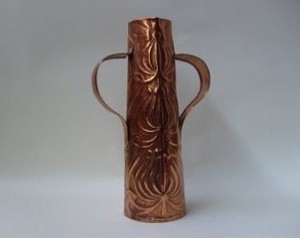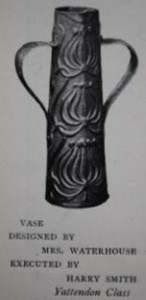My favourite object #1: a Yattendon Guild copperware vase
The first in our series of favourite objects chosen by MERL staff, volunteers and visitors, is written by Fiona Melhuish, MERL Librarian.
In my work with the Special Collections rare books and MERL library I get lots of opportunities to spotlight my favourite items from our wonderful book collections through exhibitions and Featured Items on the Special Collections website, so for this post I am going to choose one of my favourite objects from the Museum’s collections – a Yattendon Guild copperware vase (MERL 2009/24).

This vase was purchased by MERL in 2009 as part of the Collecting Rural Cultures project which aimed to acquire material to build a picture of the countryside in the twentieth century. It was made at the Yattendon Metalworking Class, or Yattendon Guild, an evening class for local men and boys, organised by Elizabeth Waterhouse (1834-1918), the wife of the architect Alfred Waterhouse, whose buildings include the Natural History Museum in London. Alfred designed several buildings in Reading including East Thorpe, a Grade II listed building, which is now the home of MERL and Special Collections. The Waterhouse family purchased the Yattendon estate in West Berkshire in 1878, and Alfred built Yattendon Court (now demolished) as their family home.
Between 1890 and 1914, the class met weekly at Yattendon Court and developed into a thriving village industry. The class produced items in repoussé brass and copper mostly from Elizabeth’s own designs – she also taught her pupils how to beat the copper and brass. The metalworker Colin Pill (who has an interesting website devoted to Arts and Crafts metalwork) has pointed out that “the handle construction on [Yattendon] vases and tankards as well as the shallow nature of the repoussé and background punching or grounding are very distinctive”. Yattendon metalware does not appear to have been stamped with a maker’s mark but some pieces occasionally bear pen inscriptions.
The class became affiliated to the Home Arts and Industries Association (HAIA) which was established in 1884 to increase skills in craftsmanship among the working classes and to promote the revival of rural craft industries. Similar metalwork classes were set up in Newlyn in Cornwall and in Keswick in the Lake District.
The Yattendon Class established a reputation for good design, and produced items including plates, jugs and lanterns in an Arts and Crafts style. The decorative motifs were inspired by plants and flowers, whilst others featured peacocks, fish, deer and leopards. The class produced over 5,000 items and sold their wares in a local shop, whilst other items were sold at Liberty’s in London. In 1895 the art and design journal The Studio praised the Yattendon Guild’s “fine show of repoussé copper, excellent in its design and thoroughly characteristic of the metal”. This vase was featured in an article in The Studio in 1899.

The vase is one of several items with a Waterhouse connection held by MERL and Special Collections. The Museum also has a tankard made by the Guild (MERL 68/506) and Special Collections holds books written by Elizabeth, correspondence and watercolours by the Waterhouse family. Neither the tankard or the vase are currently on public display in the Museum at the moment but please contact us if you would like to visit to see them!

Objects made in the Arts and Crafts style have always appealed to me, with their designs drawn from natural forms. However, what I think is particularly special about this object is the numerous links it has with different parts of our collections, from the building in which our collections are housed to local history and to the rural life and craft traditions which the Museum seeks to document and celebrate. The design of the vase has a simple beauty and a very satisfying symmetry, with the stylised plant/seed head motif gradually reducing in size as the vase tapers upwards – it would look wonderful in an Arts and Crafts-style fireplace filled with teazels!
3 thoughts on “My favourite object #1: a Yattendon Guild copperware vase”
Leave a Reply
You must be logged in to post a comment.

Very interesting post – it would be interesting to investigate Yattendon in more depth. Clearly there was a lot going on there in the late nineteenth century: Robert Bridges lived there at the same time, and married Alfred and Elizabeth’s daughter Monica, so there was a poetry and music dimension to Yattendon too. My sense is that there may have been a project of rural cultural revival at work, almost a smaller-scale and earlier version of Dartington Hall. It would be a good subject for an article or perhaps even a PhD.
Thank you for your comment, Jeremy – I think Yattendon would be an excellent subject for further research. It would be interesting to locate any records on the output of the Guild. Jill Greenaway (who I think might be a curator at Reading Museum) wrote a chapter on Elizabeth Waterhouse in the publication ‘In the Valley of the Pang’ indicating that records for the business between 1902 and 1914 do exist – I am trying to get in touch with her at the moment. I have been in contact with a member of the Waterhouse family and also the Berkshire Record Office but they do not have any business records for the Guild and suspected they might be in private ownership. If anyone has any further information on this, please do let me know!
It would also be interesting to locate other examples of Yattendon metalwork. I understand that the West Berkshire Museum has a similar tall vase to the one I talked about in my post.
Hi both,
I’ve added links to the online database records for the two pieces of Yattendon-ware held by MERL into Fiona’s blog post so you can see what information we hold about the items we have. Fiona is right that they have Yattendon Guild collections at the West Berks Museum, though I’m unsure of the precise detail of these. Perhaps there is scope for a joint exhibition at some point.
Hopefully John Holmes (https://www.reading.ac.uk/english-literature/aboutus/Staff/j-r-holmes.aspx) will touch on some of this stuff when he does his ‘pop-up’ exhibition at MERL this Autumn. Pop-up exhibitions are brief interventions whereby specialists and people with research interests in the collections select items from the reserve collections to display over the course of a single lunchtime. John is focusing on Waterhouse-related items. So, this will offer us an opportunity to get out just a few items connected with the Waterhouse family and discuss and explore them in greater depth.
Dates and final content to be confirmed but keep an eye on the Museum’s website for details.
Best,
Ollie